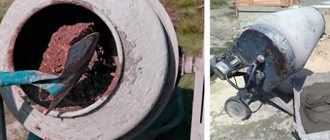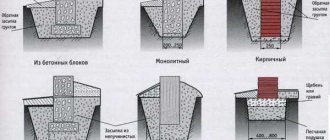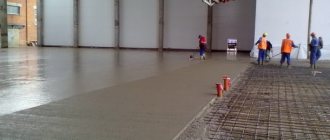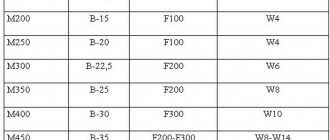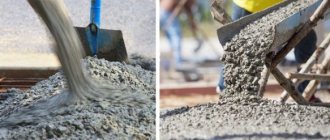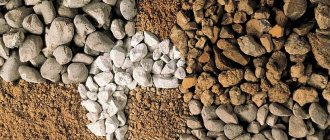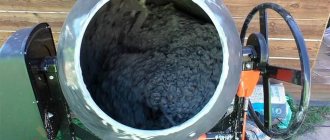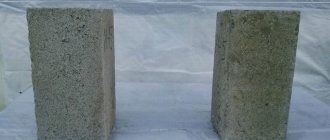Types of concrete mixers
Modern units are divided into three main types:
- Forced - they are a stationary, horizontally located tank with a rotating auger with blades inside.
- Gravity - made in the form of a rotating mixer mounted on a frame. Such concrete mixers are equipped with electric or manual drive. Some models have an internal combustion engine. At home, electrically driven devices are most often used.
- Vibrating - such models are used in industry. They are a vertically located container, into the upper part of which raw materials are supplied, and the finished product is unloaded from the lower part. Mixing of the mixture is carried out by one or more mechanical vibrators.
Types of concrete mixers
To prepare concrete solutions, equipment manufacturers today offer concrete mixers of gravity, forced and vibration types.
Gravity mixing devices are a rotating mixer mounted on a frame and driven by a drive that can be manual, electric or internal combustion engine. The most common mechanisms are electrically driven.
When the mixer rotates, the components are picked up by the blades inside it, rise to the upper part of the container and, under the influence of gravitational forces, fall down. Several minutes of such rotation guarantee a well-mixed solution.
The working capacity of gravity mixers for private construction varies from 60 to 250 liters, which allows you to choose the most suitable model for any type of work performed.
The relatively low cost of these mechanisms contributes to their widespread use both among individuals and among construction teams.
Forced-type concrete mixers are more complex in design and less common than gravity mixers. They are a stationary, horizontally located container, inside of which there is a rotating auger with blades. When the screw rotates, the embedded components are thoroughly mixed, allowing you to obtain high-quality material. The main disadvantages of such mixers include:
- the presence of sealing elements on the auger;
- more complex loading of components and unloading of the finished solution;
- high cost due to more complex design.
Vibrating concrete mixers are used in the industrial preparation of concrete mixtures. These are large-volume vertical containers with top loading of materials and bottom unloading of the finished product. Simultaneously with the components, one or more mechanical vibrators are lowered inside this container, thanks to which the solution is mixed. In private construction, devices of this type are used extremely rarely.
How the device works
Before you figure out how to mix concrete in a concrete mixer, you need to familiarize yourself with the operating principle of this mechanism. In the vast majority of households, gravity mixers powered by electricity are used, so let’s look at the operating principle of this particular device.
Electric gravity concrete mixer Source in-green.com.ua
The construction components loaded inside the metal tank are mixed due to its rotation. The blades inside the mixer pick up the solution and lift it to the top of the tank. Then, under the influence of gravity, the solution falls to the bottom of the container. To obtain a well-mixed solution, only about 10 minutes of such rotation is enough.
Advice! When purchasing a concrete mixer, you should pay attention to the volume of the working tank. It can vary from 60 to 250 liters.
The main advantages of gravity mixers are:
- Compact sizes.
- Easy to transport.
- Possibility to choose the appropriate volume.
Mechanisms of forced and vibration types are characterized by better mixing of the mixture. To obtain a strong construction mixture using a gravity concrete mixer, you will need to perform work in a certain sequence and comply with technological requirements.
Components for preparing concrete and their features
Any experienced builder knows how to properly mix concrete in a concrete mixer to get durable concrete - use only high-quality materials.
To prepare concrete, cement, gravel, sand and water are used Source 1beton.info
The standard components for its preparation are:
- Cement.
- Sand.
- Crushed stone.
- Water.
The strength of the future concrete structure depends on the quality of cement. It is necessary to choose high-quality material that contains at least 80% calcium silicate.
All types of Portland cement are marked with special signs. So, the number that follows the letter “M” means the degree of concrete’s resistance to compression after it has completely hardened. Depending on the temperature and humidity, the period for complete drying of cement can be 28-30 days. For example, if the package contains the inscription M350, then the resistance index of such cement will be 350 kg/cm². The M 450 or M 500 marking means that the density and mechanical strength of the cement is higher compared to the M 350 grade.
Each type of Portland cement is intended for specific purposes:
- M 100, M 150 – suitable for casting the base for the foundation;
- M 200, M 300 - cement with such designations is poured into foundations, blocks, retaining walls, flooring, screeds;
- M 350 - monolithic foundations, load-bearing structures, and road decks are made from this cement;
- M 400, M 450 – hydraulic structures are erected using this type of material;
- M 500, M 550 are the strongest grades of cement intended for the construction of complex objects (dams, storage facilities, subways).
When choosing cement, you need to focus on its brand Source img.aviarydecor.com
See also: Catalog of companies that specialize in foundation equipment and the manufacture of decorative forms.
The sand should not contain foreign impurities - debris, greasy clay. The most suitable fraction is 1.5-5 mm. Both purified quarry sand and sea or river sand are suitable.
Advice! For concrete, it is recommended to use coarse gravel or crushed stone with a fraction of at least 20, but not more than 70 mm.
Preparing concrete in a concrete mixer
When dealing with a concrete mixer, you need to know the exact amount of each “ingredient” in order to prepare quality concrete. It should be noted that the solution can turn out to be of different consistency, because each specific case corresponds to its own number of added components. But all the materials that make up concrete are known: cement, sand, water, crushed rocks (crushed stone or gravel). Sometimes special impurities are added to the solution.
The grade of the finished mortar obtained as a result of mixing depends on the quality of the cement itself and its proportion relative to other components. Basically, the choice falls on cement “M400” and “M500”. For example, with a ratio of “four hundredth” cement, crushed stone, sand and water, like 2-8-4-1, “M250” concrete will be produced. The “M350” grade will be obtained using “five hundredth” cement.
A certificate of conformity is the main sign of good cement; keep this in mind when purchasing it.
Each concrete mixer has its own load limit for “ingredients”, which cannot be exceeded (the drum capacity of each device is indicated in the instructions). Be sure to load the components in strict sequence: add water, add cement, sand, and then rock material (crushed stone or gravel). Make sure that the consistency and color of the finished solution in the concrete mixer is uniform.
We recommend: Kerma ceramic tiles
Component ratio
The main thing that novice builders who are thinking about how to prepare concrete in a concrete mixer needs to know is to maintain proportions.
The strength and mobility of the future structure depends on the ratio of cement, sand, gravel and water. When preparing the concrete mixture yourself, it is enough to adhere to the proportion 2 * 4 * 8 * 1.
The specified ratio makes it possible to obtain concrete of medium strength, while its quality depends on the brand of cement. So, if you use M 350 cement in the above ratio, then the grade of the finished mixture will be M200.
To obtain 60 liters of ready-made concrete solution (approximately 145-150 kg), you will need:
- cement – 21 kg;
- sand – 42 kg;
- coarse gravel - 84 kg;
- water – 10-11 l.
Instructions for use
Installation diagram for a household concrete mixer.
Installation: The concrete mixer must be installed on the ground or a flat surface, not far from the place where you will use ready-mixed concrete and lay it. After this, secure the car properly and check the brakes on all wheels. Reinstall the stabilizing lock.
Raising the container: move the mixer container to the upper, angular position (45 degrees). Fix the position of the concrete mixer itself.
Preparing the mixture: pour the cement mixture from the bags into a container. Only 1 bag of concrete can be used at a time. Carefully add sand to the container of the concrete mixer, in accordance with the instructions for the concrete mixture (located on the bag of concrete).
Connection: Determine the installation location of the heavy triple electric extension cord, connect the concrete mixer plug. The end of the extension cord must be plugged into an electrical outlet. If you have a gasoline mixer, then you need to fill the designated tank with gasoline and screw the cap tightly. Follow safety precautions!
Work: when you start working with the concrete mixer, you need to set its relay to the minimum value. Initially, the concrete mixer should operate at low speeds (until all the sand and cement become a homogeneous mass). Next, switch the speed to the middle position and fill the container with water in the required amount. Use a regular bucket to add water to the mixture.
The working process of a concrete mixer.
Completion of work: After you have completed the work and the components are mixed and ready for use, you must turn off the mixer. The resulting mixture should be slightly thick and homogeneous in consistency. Next, loosen the container lock and lower it. The concrete will be poured into the form provided for it.
Cleaning: some owners neglect this procedure, which affects the further operation of the mixer and the quality of the work performed. Be extremely careful when cleaning the concrete mixer. you must carry out this work correctly before the concrete dries.
Turn off the equipment completely and use a hose and a stream of water to wash the container. Be sure to regularly clean the concrete mixer from any remaining mixture or rust that may have gotten into the solution. Do not forget to unplug the cord from the network. Never use hard tools or hit the inside of the drum with a hammer, stones or sledgehammer. Due to damage to the drum, the quality of the solution deteriorates.
When cleaning the external surface of the drum, try to do it correctly, do not flood the motor, switch and motor ventilation holes with water. To do this, you need to use protective materials that will prevent moisture from entering.
Proportions of concrete in buckets
It is difficult to focus on the weight of materials when drawing up proportions, since they may have different fraction sizes and humidity. At home, small amounts of construction work are often carried out. Therefore, to make it easier to figure out how to properly mix concrete in a concrete mixer, the proportions are in buckets.
Attention! All components that make up the building mixture have different volumetric mass.
When drawing up proportions for mixing concrete mixture at home, use buckets Source vsebeton.ru
how to use a concrete mixer?
To do this, you first need to grab a special handle or wheel, which is usually located on the left side of the concrete mixer. They are pulled towards themselves, after which the latch is released and the drum can be tilted down. Unlocking the lock by pulling the handle or wheel towards you is not the best option.
It is much more reliable if a special foot pedal is provided for this purpose. The fact is that it works flawlessly and is not as susceptible to backlash and wear as a conventional handle lock.
Rules for working with a concrete mixer
Not every master who is well versed in the intricacies of preparing concrete mixtures knows how to properly mix concrete in a concrete mixer. Mixing with a shovel in a handy container, for example, a metal basin, is somewhat different from working with a concrete mixer.
Proper use of a concrete mixer will significantly extend its service life Source plita.guru
And although the use of a special unit greatly facilitates the work process, ignoring the rules for handling it can lead to negative results, including damage to expensive equipment:
- The adhesion of sand and cement to the walls and blades leads to a decrease in their proportion in the finished mixture. Therefore, during the first batch, it is recommended to pre-wet the walls of the rotating drum with liquid cement mortar, or increase the amount of cement and sand by 10%.
- You cannot unload the mixture from the drum using a shovel.
- Untimely washing of the drum after completion of work is not allowed. Hardened solution residues can cause damage to the faucet elements and sticking of the drain holes.
- Immediately after using and washing the concrete mixer, you must disconnect it from the power supply.
Tricks of working with a concrete mixer: mixing correctly
To increase the durability of the concrete mixer, and therefore the efficiency of its operation, proper operation is necessary. Before adding the first component while preparing concrete, make sure that the unit is on a horizontal surface and is stable. Even a slight change in the angle of inclination of the body can spoil the result: poor quality of the solution and a decrease in the service life of the forced-action unit.
Each type of concrete mixer has its own time during which concrete is produced. Gravity devices operate for 120 seconds, forced action devices cope in 60 seconds. By increasing the time for preparing concrete in a concrete mixer, you risk getting a solution with low plasticity, because more water has evaporated than needed. To check the quality of the resulting mixture, you need to pour a little solution into a trough and make several “cuts” using a wide shovel. If the shape of such “cuts” does not change its structure, that is, it holds, then the concrete is of good quality.
During the mixing process, the solution “settles” on the drum and blades of the device. In this situation, the finished mixture may not receive a little sand and cement, so during the initial mixing we recommend pouring 1/10 more of these materials. If you have a special “working off”, you can wipe the drum and blades with it to reduce the sticking of components. After the last batch, it is necessary to wash the inside of the concrete mixer, since once it has dried, the solution cannot be removed without compromising the integrity of the structure of the device (if it is not disassembled).
You can only throw in the components and take out the finished solution if the drum is rotating.
After reading this article, you have all the information you need to prepare high quality concrete. Listen to the advice described above and follow the rules for operating such an important assistant as a concrete mixer.
Operating procedure
Above we looked at how to mix concrete in a concrete mixer, in what proportions to use building materials, and what rules should be followed when working with the device. Finally, it is worth considering the technology of using a concrete mixer in stages.
The concrete mixer should be installed in a place convenient for work. Source www.totaltoolrental.com

